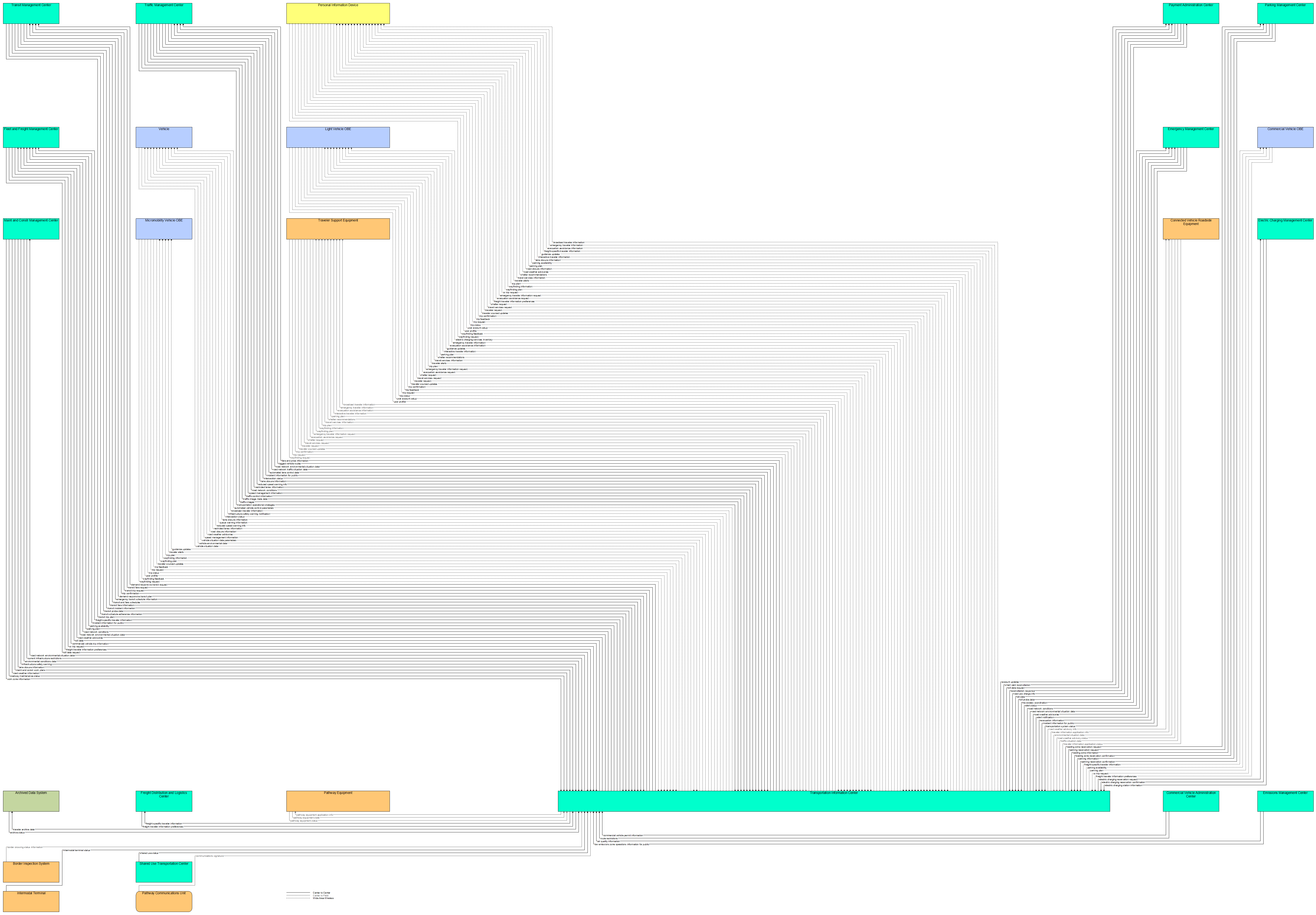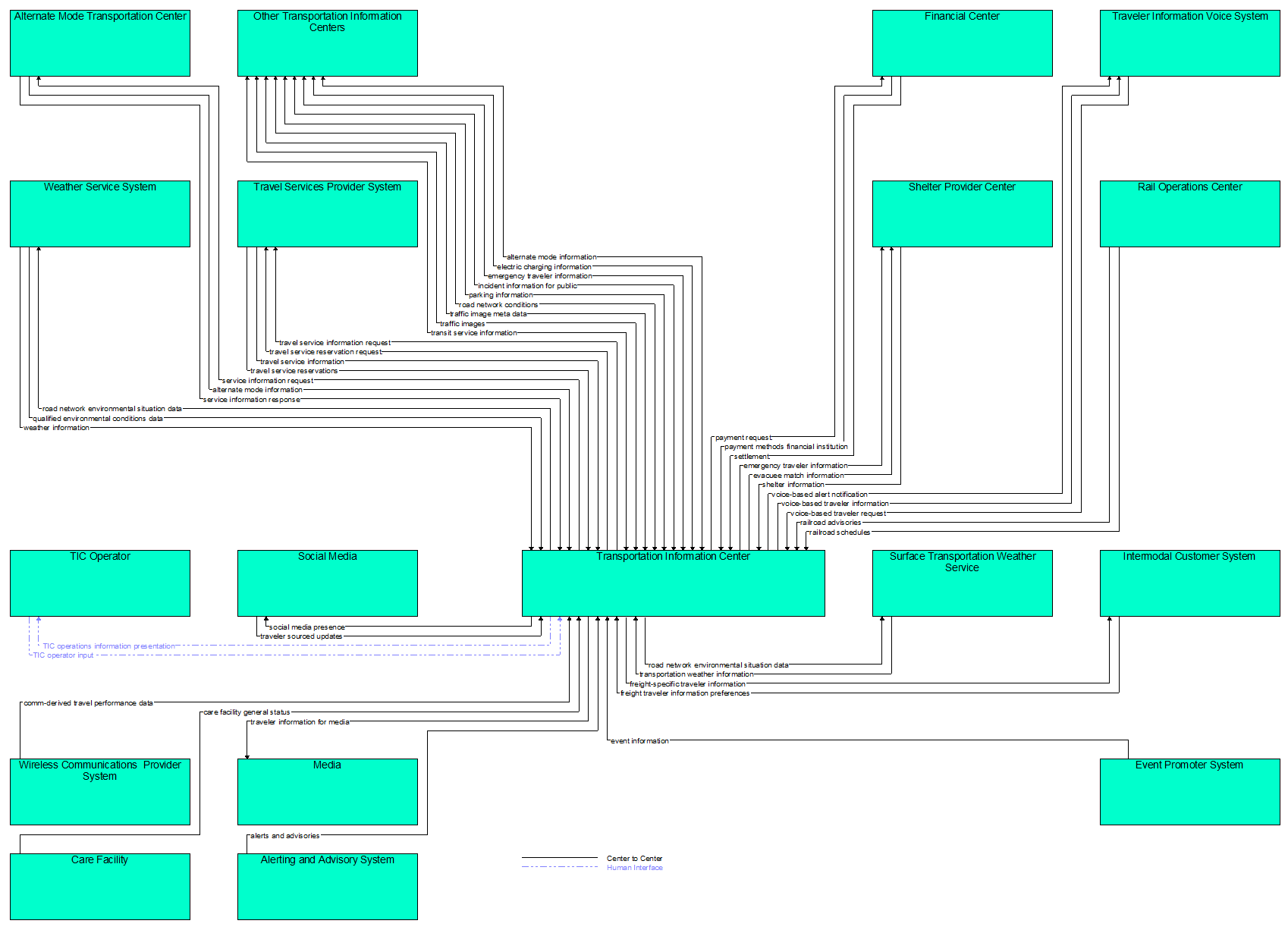Kind: Subsystem
Class: Center
Type: System
Transportation Information Center
Overview
The 'Transportation Information Center' collects, processes, stores, and disseminates transportation information to system operators and the traveling public. The physical object can play several different roles in an integrated ITS. In one role, the TIC provides a data collection, fusing, and repackaging function, collecting information from transportation system operators and redistributing this information to other system operators in the region and other TICs. In this information redistribution role, the TIC provides a bridge between the various transportation systems that produce the information and the other TICs and their subscribers that use the information. The second role of a TIC is focused on delivery of traveler information to subscribers and the public at large. Information provided includes basic advisories, traffic and road conditions, transit schedule information, yellow pages information, ride matching information, and parking information. The TIC is commonly implemented as a website or a web-based application service, but it represents any traveler information distribution service.
This physical object is included in the following Service Packages:
- CVO01: Carrier Operations and Fleet Management
- CVO04: CV Administrative Processes
- CVO05: Commercial Vehicle Parking
- CVO06: Freight Signal Priority
- CVO09: Freight-Specific Dynamic Travel Planning
- CVO10: Road Weather Information for Freight Carriers
- DM01: ITS Data Warehouse
- MC04: Winter Maintenance
- MC06: Work Zone Management
- MC08: Maintenance and Construction Activity Coordination
- MC10: Asset Tracking
- MC11: Maintenance and Construction Signal Priority
- MC12: One-Way Convoy Driving
- PM01: Parking Space Management
- PM02: Smart Park and Ride System
- PM04: Regional Parking Management
- PM05: Parking Reservations
- PM06: Loading Zone Management
- PS01: Emergency Call-Taking and Dispatch
- PS03: Emergency Vehicle Preemption
- PS06: Incident Scene Pre-Arrival Staging Guidance for Emergency Responders
- PS07: Incident Scene Safety Monitoring
- PS08: Roadway Service Patrols
- PS10: Wide-Area Alert
- PS13: Evacuation and Reentry Management
- PS14: Disaster Traveler Information
- PT01: Transit Vehicle Tracking
- PT02: Transit Fixed-Route Operations
- PT03: Dynamic Transit Operations
- PT04: Transit Fare Collection Management
- PT05: Transit Security
- PT08: Transit Traveler Information
- PT09: Transit Signal Priority
- PT10: Intermittent Bus Lanes
- ST01: Emissions Monitoring
- ST05: Electric Charging Stations Management
- ST06: HOV/HOT Lane Management
- ST07: Eco-Lanes Management
- ST08: Eco-Approach and Departure at Signalized Intersections
- ST09: Connected Eco-Driving
- ST10: Low Emissions Zone Management
- TI01: Broadcast Traveler Information
- TI02: Personalized Traveler Information
- TI03: En-Route Guidance
- TI04: Trip Planning and Payment
- TI05: Integrated Multi-Modal Electronic Payment
- TI06: Shared Use Mobility and Dynamic Ridesharing
- TI08: Personal Wayfinding
- TI09: Travel Services Information and Reservation
- TM01: Infrastructure-Based Traffic Surveillance
- TM02: Vehicle-Based Traffic Surveillance
- TM04: Connected Vehicle Traffic Signal System
- TM06: Traffic Information Dissemination
- TM08: Traffic Incident Management System
- TM09: Integrated Decision Support and Demand Management
- TM10: Electronic Toll Collection
- TM11: Road Use Charging
- TM15: Railroad Operations Coordination
- TM18: Drawbridge Management
- TM19: Roadway Closure Management
- TM21: Speed Harmonization
- TM22: Dynamic Lane Management and Shoulder Use
- TM23: Border Management Systems
- VS04: Special Vehicle Alert
- VS07: Road Weather Motorist Alert and Warning
- VS08: Queue Warning
- VS09: Reduced Speed Zone Warning / Lane Closure
- VS10: Restricted Lane Warnings
- VS12: Vulnerable Road User Safety
- VS13: Intersection Safety Warning and Collision Avoidance
- VS15: Infrastructure Enhanced Cooperative Adaptive Cruise Control
- VS17: Automated Vehicle Operations
- VS19: Vulnerable Road User Clustering
- WX01: Weather Data Collection
- WX02: Weather Information Processing and Distribution
- WX03: Spot Weather Impact Warning
Functionality
Triples
Security
This physical object has the following security levels for the associated service packages.
This interfaces diagram had many interfaces and so was broken up into a Subsystem and Terminator interfaces diagram.
Subsystem Interfaces Diagram

Standards
Currently, there are no standards associated with the physical object itself though the interfaces may have standards associated with them. For standards related to interfaces, see the specific information flow triple pages.
